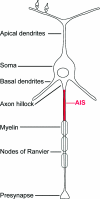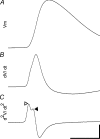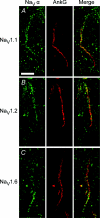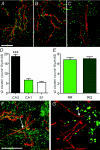Axon initial segment dysfunction in epilepsy
- PMID: 20375142
- PMCID: PMC2901971
- DOI: 10.1113/jphysiol.2010.188417
Axon initial segment dysfunction in epilepsy
Abstract
The axon initial segment (AIS) contains the site of action potential initiation and plays a major role in neuronal excitability. AIS function relies on high concentrations of different ion channels and complex regulatory mechanisms that orchestrate molecular microarchitecture. We review recent evidence that a large number of ion channels associated with epilepsy are enriched at the AIS, making it a 'hotspot' for epileptogenesis. Furthermore, we present novel data on the clustering of GABRgamma2 receptors in the AIS of cortical and hippocampal neurons in a knock in mouse model of a human genetic epilepsy. This article highlights the molecular coincidence of epilepsy mutations at the AIS and reviews pathogenic mechanisms converging at the AIS.
Figures




Similar articles
-
Trafficking mechanisms underlying neuronal voltage-gated ion channel localization at the axon initial segment.Epilepsia. 2012 Dec;53 Suppl 9(Suppl 9):21-31. doi: 10.1111/epi.12032. Epilepsia. 2012. PMID: 23216576 Free PMC article. Review.
-
Electrogenic tuning of the axon initial segment.Neuroscientist. 2009 Dec;15(6):651-68. doi: 10.1177/1073858409341973. Neuroscientist. 2009. PMID: 20007821 Free PMC article. Review.
-
The physiology of the axon initial segment.Annu Rev Neurosci. 2012;35:249-65. doi: 10.1146/annurev-neuro-062111-150339. Epub 2012 Mar 20. Annu Rev Neurosci. 2012. PMID: 22443507 Review.
-
Signal processing in the axon initial segment.Neuron. 2012 Jan 26;73(2):235-47. doi: 10.1016/j.neuron.2012.01.007. Neuron. 2012. PMID: 22284179 Review.
-
Short- and long-term plasticity at the axon initial segment.J Neurosci. 2011 Nov 9;31(45):16049-55. doi: 10.1523/JNEUROSCI.4064-11.2011. J Neurosci. 2011. PMID: 22072655 Free PMC article. Review.
Cited by
-
Blast wave exposure impairs memory and decreases axon initial segment length.J Neurotrauma. 2013 May 1;30(9):741-51. doi: 10.1089/neu.2012.2478. Epub 2013 Feb 6. J Neurotrauma. 2013. PMID: 23025758 Free PMC article.
-
Ecm29-mediated proteasomal distribution modulates excitatory GABA responses in the developing brain.J Cell Biol. 2020 Feb 3;219(2):e201903033. doi: 10.1083/jcb.201903033. J Cell Biol. 2020. PMID: 31910261 Free PMC article.
-
Enrichment of GABAA Receptor α-Subunits on the Axonal Initial Segment Shows Regional Differences.Front Cell Neurosci. 2016 Mar 1;10:39. doi: 10.3389/fncel.2016.00039. eCollection 2016. Front Cell Neurosci. 2016. PMID: 26973458 Free PMC article.
-
Neurological channelopathies: new insights into disease mechanisms and ion channel function.J Physiol. 2010 Jun 1;588(Pt 11):1823-7. doi: 10.1113/jphysiol.2010.190652. Epub 2010 Apr 7. J Physiol. 2010. PMID: 20375141 Free PMC article. Review.
-
Burden analysis of rare microdeletions suggests a strong impact of neurodevelopmental genes in genetic generalised epilepsies.PLoS Genet. 2015 May 7;11(5):e1005226. doi: 10.1371/journal.pgen.1005226. eCollection 2015 May. PLoS Genet. 2015. PMID: 25950944 Free PMC article.
References
-
- Abramoff MD, Magelhaes PJ, Ram SJ. Image processing with ImageJ. Bioph Intern. 2004;11:36–42.
-
- Araki T, Otani T. Response of single motoneurons to direct stimulation in toad's spinal cord. J Neurophysiol. 1955;18:472–485. - PubMed
-
- Audenaert D, Claes L, Ceulemans B, Lofgren A, Van Broeckhoven C, De Jonghe P. A deletion in SCN1B is associated with febrile seizures and early-onset absence epilepsy. Neurology. 2003;61:854–856. - PubMed
-
- Audenaert D, Van Broeckhoven C, De Jonghe P. Genes and loci involved in febrile seizures and related epilepsy syndromes. Hum Mutat. 2006;27:391–401. - PubMed
-
- Baulac S, Huberfeld G, Gourfinkel-An I, Mitropoulou G, Beranger A, Prud’homme JF, Baulac M, Brice A, Bruzzone R, LeGuern E. First genetic evidence of GABAA receptor dysfunction in epilepsy: a mutation in the γ2-subunit gene. Nat Genet. 2001;28:46–48. - PubMed
Publication types
MeSH terms
Substances
LinkOut - more resources
Full Text Sources
Other Literature Sources
Medical

